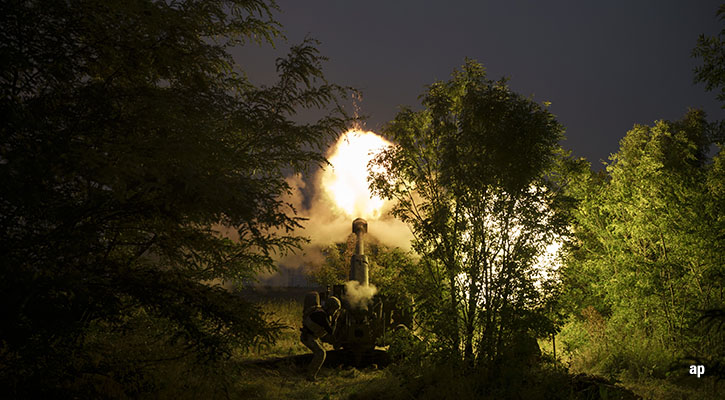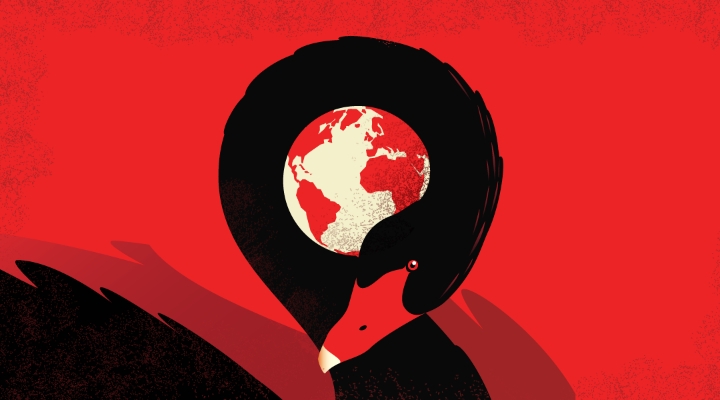
Russia’s invasion of Ukraine in February 2022 triggered another period of anxiety and self-reflection for investors.
Again they’d failed to appreciate the risk to global stability posed by the Putin regime and that meant risk assets had to be re-priced again, following a period of recovery after the pandemic (itself a largely-unanticipated event). Markets switch from fear to complacency very quickly, as shown in March when we suddenly had to start thinking about the potential for another global banking crisis.
Risks never really go away, it’s just that investors are occasionally able to press "mute" on their anxieties for periods and hope for the best.
In the very long term, you can see how catastrophic events (9/11, the financial crisis of 2008-9, the Iraq War, the Covid-19 pandemic) can be overcome. At the time, however, these feel like events to change the world forever, and on a geopolitical level, this may be the case. It’s just that, as an equity or bond investor, you have to develop an amnesia to move forward. "This changes everything" quickly becomes "this time it’s different".
In the wake of last year's invasion we wrote about how Russia had changed risk. In mid-2023, these risks are still with us – and will probably always be there. New ones are emerging too. Yesterday we covered artificial intelligence risk, among other things.
With all that in mind, here are 10 risks that never disappear.
Geopolitical Risk
As Ukraine launches its counter-offensive against Russia and China mulls its next move in Asia-Pacific, geopolitical risk seems the biggest threat. Regimes can go rogue overnight, but others were rogue all along and no one noticed (or chose not to notice). My colleague Tom Lauricella has opined on this. We’re in a world where anti-democratic regimes such as China and Saudi Arabia wield significant power, whether economic or political. "Containment" is always preferable to conflict, but Russia has exposed the weakness of the former approach.
Emerging Market Risk
This is closely linked to the above point. As countries grow economically, political stability often increases, but there are plenty of counter examples. Developing countries can often surprise on the downside, and the rise of populist "strongmen" (Orban, Erdogan and Bolsonaro) poses difficult moral questions for investors.
Single Country Fund Risk
This too is a connected point. Taiwan has outperformed emerging markets indices in the last 10 years because of its semiconductor prowess. Now investors are cautious over the threat of a Chinese invasion. Funds exposed to the country have had a good run but things can change rapidly.
Single Stock Risk
A company’s value can fall dramatically, as we saw during the March banking crisis when Credit Suisse was rescued at a discount by UBS. Investors can be wiped out very easily if a stock goes to zero.
Currency Risk
EM currencies can really tank, and fast. That can crush equity and debt investors' returns if things go south, and assets are denominated in local currencies. The Turkish lira has recently hit another record low against the US dollar. But rich countries can’t be too complacent either. While their currencies are less volatile, a “weak” currency can invite short sellers and make imports more expensive, exacerbating the effects of inflation for key products like energy and food.
ESG Risk
This is a very large umbrella term that encompasses humanity’s biggest challenge this century: climate risk. But it can cover a range of day-to-day issues including employee relations, controversy and social issues. Corporate reputations can be sunk quickly on just one scandal. Some can be tarnished by moving too slowly on issues people find important.
Liquidity Risk
Markets are designed around the idea of matching buyers and sellers. But the "rush for the exits" is seen time and again during market panics. In these times, it’s often hard for investors to get out quickly enough. In hindsight, it can be better to wait for the panic to subside before selling. On the other hand, terminal cases often provide plenty of opportunities for investors to escape with some capital intact.
Credit Risk
Sovereign and corporate bonds notionally offer less risk than equities. But the likelihood of default can never be entirely ruled out, as the US debt ceiling saga reminded us. Countries' debt piles get bigger and bigger, intensifying risks to future generations. Fixed income offers a whole different palette of risks, which we’ve looked at in a different article.
Inflation Risk
After years of tame inflation, this risk has become severe in the last year or so. It's become the biggest issue for governments, policymakers and households in the US, Europe and UK. Food inflation has pushed many emerging countries to the brink of crisis, thus inflaming political risk. Inflation changes the dynamics of economies and assets in ways that are almost always damaging to wealth.
Regulatory Risk and Moral Hazard
We accept regulation in financial markets to keep the worst criminals away from our money and to provide a safety net for consumers when things go wrong. The debate about how much regulation is right to balance risk and opportunity is an eternal one. Periods of lax regulation are often followed by tough new rules, extra layers of compliance and the creation of new regulatory bodies.
Moral hazard has become a real issue since the financial crisis. Those affected by the US banking collapses in March effectively were backstopped by the state, but should they have been? In the US, $250,000 of savings are protected, and lawmakers are thinking of raising that in the wake of the collapse of several regional banks.
In the case of one of these, Silicon Valley Bank (SVB), people with more than this amount were protected - they were "made whole" by the US Treasury. What signal does that send to people setting up these companies, and the people who lend them money?
A Bonus Risk: Crypto
As SVB was a tender to the tech and crypto industries, this is an example of how "everyday money" can overlap with more speculative ventures.
Crypto has opened up a whole new world of risk (and reward) and US regulators have recently set their sights on the industry, taking legal action against Binance and Coinbase. And then there's Sam Bankman Fried and FTX.
This a live test case of when speculation meets regulation. It's the US regulatory system versus the "Wild West" of crypto. The "winner" will set the parameters of financial market risk in the coming decades.




























